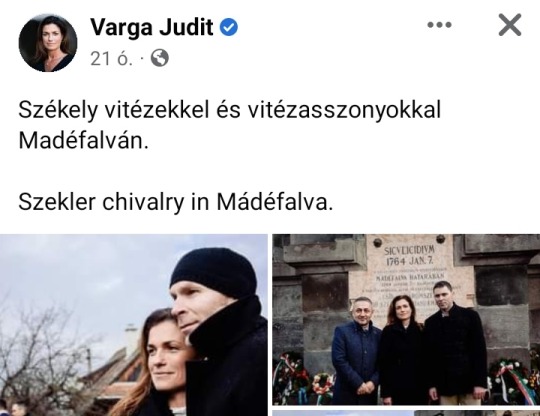#szeklers
Text
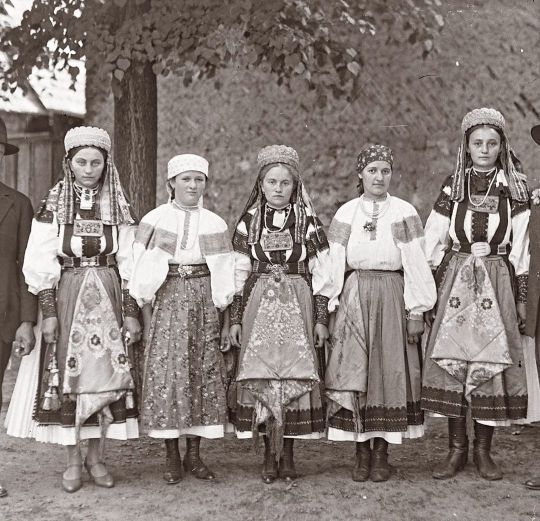
Group of young Székely girls From Rimetea / Torockó, Alba, Transylvania
Not dated (interwar period), photographer/source not credited – via transylvania.heritage
126 notes
·
View notes
Photo

🇬🇧 Self-guided tours on your phone! 📲 Turn your phone into a personal audio tour guide to accompany you on your travel adventures. SmartGuide acts like a live guide, guiding visitors around and talking to them automatically when they reach an interesting spot. Gamification is used to make guide content more engaging and bring it to life with audio narration and Augmented Reality (AR). 🇷🇴 Tururi autoghidate pe telefon! 📲 Transformați-vă telefonul într-un ghid turistic audio personal care să vă însoțească în aventurile dumneavoastră de călătorie. SmartGuide se comportă ca un ghid viu, ghidându-i pe vizitatori și vorbindu-le automat atunci când ajung într-un loc interesant. Gamificarea este utilizată pentru a face conținutul ghidului mai atractiv și pentru a-l aduce la viață cu ajutorul narațiunii audio și al realității augmentate (Augmented Reality). 🇭🇺 Önvezető túrák a telefonjukon! 📲 Tegye a telefonját személyes audio idegenvezetővé, amely elkíséri Önt utazási kalandjai során. A SmartGuide úgy viselkedik, mint egy élő idegenvezető, aki kalauzolja a látogatókat, és automatikusan beszél hozzájuk, amikor egy érdekes ponthoz érnek. A játéktechnika segítségével az idegenvezetői tartalom még vonzóbbá válik, és hangos narrációval és kiterjesztett valósággal (Augmented Reality) életre kel. ❕SmartGuide 🇷🇴 🇬🇧 🇫🇷 🇩🇪 🇭🇺 #visitkezdi #kezdi #Kézdivásárhely #udvarterek #székely #Transylvania #Erdély #GáborÁron #szekler #travel #tourism #VisitCovasna #architecturelovers #photographylover #photooftheday #travelphotography #traveltheworld #exploringtheworld #ig_romania #targusecuiesc #szeklerneumarkt #passionpassport #bbctravel #visualsoflife #LonelyPlanet #culturaltourism #traveladdict #transylvania #ig_europe #instagood (at Kézdi TourInform) https://www.instagram.com/p/CjAHvIfoRlz/?igshid=NGJjMDIxMWI=
#visitkezdi#kezdi#kézdivásárhely#udvarterek#székely#transylvania#erdély#gáboráron#szekler#travel#tourism#visitcovasna#architecturelovers#photographylover#photooftheday#travelphotography#traveltheworld#exploringtheworld#ig_romania#targusecuiesc#szeklerneumarkt#passionpassport#bbctravel#visualsoflife#lonelyplanet#culturaltourism#traveladdict#ig_europe#instagood
8 notes
·
View notes
Photo


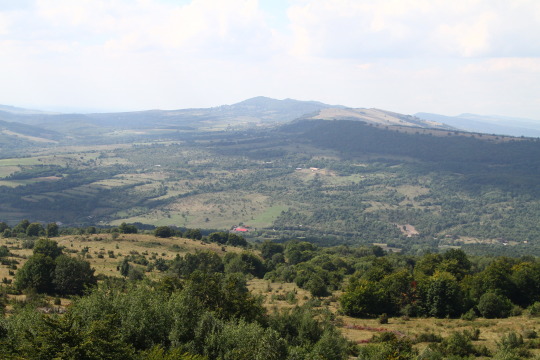

3 notes
·
View notes
Text
Through the Maramures and the Szeklers Gates, in Dreamland, for Thursday Doors
Through the Maramures and the Szeklers Gates, in #Dreamland
#ThursdayDoors #Im4Ro #architecture #AdoorableThursday #woodworking #Romania #art
Passing through wood-carved gates, such as the Maramures or the Szeklers gates is a memorable experiences, as I discovered during the research for my latest book, Dreamland.
(more…)

View On WordPress
#ThursdayDoors#comparing Maramures and Szeklers gates#in Dreamland#Maramures gates#paintd wooden gates#Szeklers Gates#thursday doors#wood carved gates
0 notes
Text

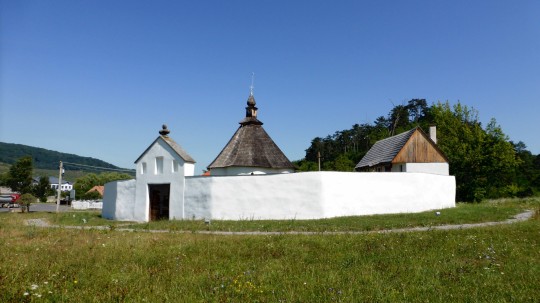



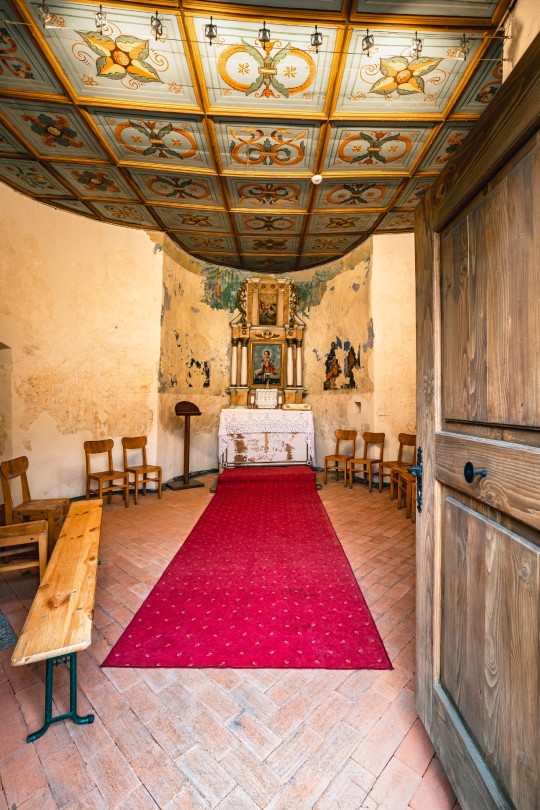
Chapel dedicated to the Heart of Jesus in Odorheiu Secuiesc, Romania.
Very rare rotunda surrounded with defensive walls. It belongs to local Szekler community. Built in 16th century, it's square coffered ceiling was made in 1677 and defensive walls added in 1771.
51 notes
·
View notes
Text
I am going to the Székely Land to visit the Szekler Border Guard Memorial Center. What should I report about?
11 notes
·
View notes
Text
Because of Dracula Daily, apparently I'm rereading Dracula again, whoo! I find Harker's earlier recollections of his travels funny but also extremely Victorian British. This time, I read an excellent article, Dracula’s Kitchen: A Glossary of Transylvanian Cuisine, Language, and Ethnography by Cristina Artenie, quoting the relevant bit from this article below:
At Bistritz, on May 3rd, Jonathan Harker is having breakfast at Hotel Royale in Klausenburg, central Transylvania.
“I had for breakfast more paprika, and a sort of porridge of maize flour which they said was ‘mamaliga’ and eggplant stuffed with forcemeat, a very excellent dish, which they call ‘impletata.’”
Harker notes that he had “paprika, and a sort of porridge of maize flour,” which is indicative of the fact that he ate in a Romanian kitchen. Mămăligă is indeed corn mush, served as a side dish that is often a stand-in for bread. While Hungarians in Transylvania have adopted the corn mush for their ordinary meals, they would not have served it in a restaurant. For this reason, it is hard to believe that Harker was, indeed, served chicken paprikash with mămăligă at all, as this mix is a traditional Romanian peasant mix, and the hotels in Klausenburg (at the time the unofficial capital of Transylvania, heavily populated by Hungarians and Saxons) were not managed by and did not employ Romanians.
The hierarchy of the province recognized the Saxons, the Hungarians, and the Szeklers as the only three governing nations, while the Romanians were relegated to the margins of society. If Harker dined, indeed, in Klausenburg, he must have had paprikahendl with potatoes as a side dish, or with dumplings. It is more likely that he encountered Romanians and Romanian cuisine in Bistritz, a much smaller town, a frontier town with an overwhelmingly Romanian population (all of the statistics give 68% and more Romanians in Bistritz and the surrounding area, some Saxons, some Hungarians, and no Slovaks).
If the “paprikahendl” with “mamaliga” is problematic as it raises doubts about Harker’s recollections of his trip, the famous stuffed eggplant is a true challenge and highlights Harker’s inability with languages. Impletata is in fact a mix of two, or even three Romanian words (none of which means eggplant): împletită, which is a type of braided bread; umplută, an adjective that means stuffed; and împănată, another adjective that means half-stuffed, or feathered, meaning that the inside of the “eggplant” (to keep with Harker’s menu) is not scooped out, but that the “eggplant” is sliced on the surface and other vegetables are inserted halfway. In fact, there are lots of recipes of vegetables and meats that can either be umplută or împănată, while only the bread is împletită.
Without mentioning the fact that impletata is not a word in the Romanian lexicon, Klinger notes that “[t]he simplest version of impletata is a scooped-out eggplant with the pulped eggplant, ground meat, breadcrumbs, and butter, and baked. Dozens of recipes are widely available in English, under ‘stuffed eggplant.’” Similarly, Leatherdale observes: “‘Mamaliga’ and ‘impletata’ come from Johnson (p. 120): ‘Egg plant stuffed with chopped meat is National Dish and called ‘Ua Impletata.’” Both these descriptions refer to stuffed eggplant, which in Romanian would be vânătă umplută. The “Ua” in Johnson’s text, reproduced by Leatherdale, could be an attempt to write down the Transylvanian pronunciation of “o,” which is the Romanian feminine indefinite article, i.e., “a”, as in “a[n] impletata.” It is even possible that Johnson confused “o” with “una,” the Romanian feminine cardinal numeral, i.e., “one.”
And while food could seem a minor entry, it shows in nuce that Harker’s experience is at best the sum of confusions of tastes, languages, and of peoples and not an accurate portrayal of Transylvania. In an anti-colonial reading, however, it could easily be regarded as a colonial gesture to name, assign meaning, and redraw the map of a newly discovered territory.
#I find Harker naive and love to make fun of him being SO British#but as far as favourite characters go my heart will forever be with Mina#long post#queue
109 notes
·
View notes
Photo



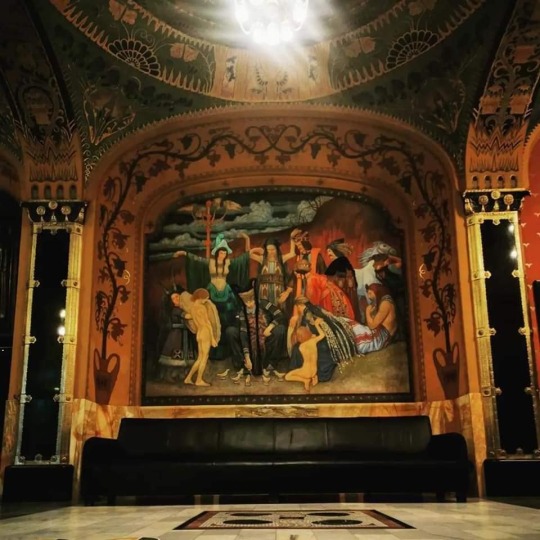








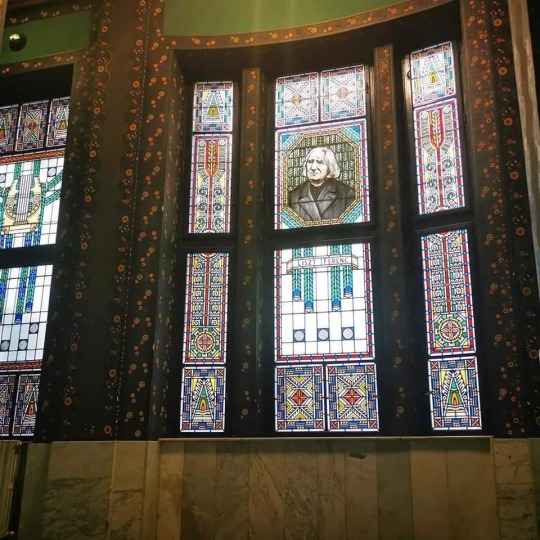




The Palace of Culture of Targu-Mures in Romania.
~ “The Palace of Culture in Targu-Mures is an architectural jewel, one of the most representative Belle Epoque buildings from Romania. Construction started in 1911 and lasted until 1913 when the inside decorations were completed. The Palace has a striking facade of mosaics and bas-reliefs in bronze and stone, frescoes and stained glass. The Art Nouveau edifice, designed in Secession style, has 3 buildings: the main building, the right building and the left building. Above of the Entrance Hall is the Mirrors’ Hall, located on the first floor of the building. With a capacity of 700 seats, the multifunctional Concert Hall forms the central part of the building. Its height corresponds to the three levels of the building. With more than 200 seats, the Small Hall, beautifully decorated with floral motifs, is used for cultural and scientific conferences, and for various recitals and concerts. The building is home to the State Philharmonic of Târgu Mureș (founded in 1950), the Mureș County Library (since 1913), the art galleries of the Mureș County Museum, and hosts various exhibitions and events of the Târgu Mureș branch of the Visual Artists’ Union of Romania. The inside of the palace housed the City Cinema between 1913 and 1957, the first Romanian Theatre School between 1934 and 1940, the State Theatre of Târgu Mureș between 1946 and 1973, the Fine Arts and Music Secondary School between 1949 and 1970, the Academy of Fine Arts between 1932 and 1949 and the County House for Guidance of Folkloric Creation between 1950 and 1999.Palace of Culture composed of six halls: Music Hall, which extends over three floors of the building, has an extraordinary acoustics, which turns it into a perfect hall for concerts.Small Hall has a very central stained glass and chandeliers. Here are held plays and small concerts.Hall of Mirrors is decorated with Venetian mirrors and the tables in the room are tiled with mirrors too. Each stained glass has a story: Szekler scenes from fairy tales, ballads and legends. Bernády Hall bears the name of one of the most active mayors of city Bernády György. Dandea Hall is dedicated to a romanian mayor, Aurel Dandea, who played an important role in city modernisation. Secession Hall has an exhibition of the most important buildings in Targu-Mureș and stained glass portrait.” ~
8 notes
·
View notes
Text
!! disclaimer : roleplay, fakeland.
Savant city, primera actividad narrativa.
Toma los sobres con prisa, regresando al cálido interior de la vivienda que comparte con sus hermanos, el invierno no perdonaba y llevaban días en los que la nieve les hacía la vida imposible. A medida que caminaba en dirección a la cocina revisa la información de las cartas, encontrando particularmente curioso ver una donde su nombre estaba escrito. “Savant city”, se leía junto a él, era un sobre sobrio y sin mucha información adicional más que la propia.
—Me llegó una carta. —anuncia a sus hermanos, que le esperaban en la cocina para desayunar. —Y ya llegaron las cuentas, Rafa.
Mofa con confianza, a sabiendas que el mencionado era el encargado de los gastos de todos en el hogar. Era el hermano mayor, quien adoraba consentir y cuidar de sus hermanos y protegidos. Dylan se acerca con cautela al peliblanco, observando con atención en búsqueda de aquella mencionada carta que tenía como destinatario a su hermano.
—¿Qué dice? —le pregunta, tomando los demás sobres con un único nombre impreso en ellos "Rafael Szekler".
—La destapas luego, Jace, comamos primero.
Tal como había dicho Rafael, se hizo. La comodidad económica para los menores venían con la responsabilidad y deber de acatar las órdenes cuando se les daban. Además, ya tenía hambre y eran sus panqueques favoritos.
La espera por fin había llegado a su fin, Jace se encontraba en su habitación, acompañado sólo por su mascota, y decide abrir el sobre. La confusión no tarda en hacerse presente, no entendía exactamente por qué era él el citado a tan prestigioso lugar. ¿Genio? Bueno, no era una persona con falta de inteligencia, pero temía considerarse en aquella categoría tan especial, no tenía la estima personal suficiente para ello.
Tras la confusión, se acercan la duda, la negación y el descarte. Pese a considerarse una persona ingenua, aquella broma era el límite, un límite el cual se decide a no cruzar y con un ademán guarda aquél sobre que contenía una carta y un boleto en el cajón de su escritorio. ¿Quién podría jugarle aquella broma tan pesada? Pintar una idea tan extravagante, conseguir falsificar el boleto y hacerlo llegar hasta la puerta de su casa, demasiado trabajo para tan mala broma.
Una negación rotunda que se convierte en euforia y exaltación al escuchar a la presentadora del noticiero avisando el popular y nuevo suceso. Otra vez ese nombre: "Savant city".
—¡Yo estoy invitado! —exclama, colocándose de pie de inmediato, mientras observaba a sus compañeros de casa.
—Invitado a lavar los pisos, tal vez. ¿Cómo vas a estar invitado tú a un evento para personas extraordinarias?
—Mira, mononeuronal, lo que tú tienes no es contagioso. Yo sí soy inteligente.
—¿Cómo me dijiste?
—No empiecen, déjenme escuchar. —murmura Dylan, deteniendo la pequeña pelea entre Leah y Jace que apenas comenzaba. Oportunidad para el chico de correr hasta su habitación, rebuscando en el cajón para tomar el sobre y volver hasta donde estaban todos, enseñando la invitación con falsa superioridad sobre la fémina, pues lo acercaba al rostro de esta.
—Pues es verdad... —murmura esta, entre sorprendida y derrotada.
—¿Esa fue la carta que te llegó hace días? Con razón no me contaste después qué había sido.
Rafael se desplaza hasta estar cerca de los menores, pidiendo leer el contenido antes de expresar una sonrisa y abrazar por los hombros a su hermano extraordinario. Una felicitación implícita permite el flujo de palabras animando al muchacho, pues ya no había forma de negar la realidad de aquél evento. Savant city sería el próximo destino de Jace.
La corta rememoración del chico finaliza con la aparición de los edificios ante su vista, el trayecto en barco había sido más largo de lo esperado y por fortuna tuvo oportunidad de encontrarse rostros familiares con los cuales conversar de los sucesos, pero pronto su atención fue arrebatada por el lugar al que se dirigían.
La magnitud de las construcciones le hacía reafirmar una vez más lo diminuto que era, un sentimiento de insignificancia siempre lograba hacerse en Jace cuando pensaba en lo pequeño que era todo lo que él podía hacer en contraste con todos los avances de la humanidad o con todo el universo fuera de su planeta que no conocía. Las calles se sentían amplias y ajenas, estaba lejos de su familia con un futuro desconocido, y aunque la idea de vivir algo nuevo le hacía sentir emoción, no podía negar que tenía miedo.
¿Verdaderamente encajaría en un lugar lleno de personas extraordinarias? ¿En qué edificio terminaría? La última duda le hizo reír, estaba camino al sorteo de casas, ¿sería Ravenclaw? ¿Slytherin tal vez? Las tres opciones presentes en Savant city se sentían distantes.
Arte, no era una persona virtuosa, siempre había sido su sueño frustrado.
Tecnología, tampoco conocía de ese tema y en reiteradas ocasiones se sentía como un anciano en medio de jóvenes.
Ciencia, mucho menos era algo que se le daba bien... Pero debía aceptar que era lo más cercano a aquello que se había dedicado a estudiar. O al menos de eso quiso convencerse cuando Hunter y Nikita le habían asignado ese edificio.
—Al menos estamos juntos. —murmura a su nueva vecina y gran amiga Shinebi. La presencia de personas conocidas en su mismo edificio le transmitía paz, si se esforzaba en desarrollar sus habilidades tal vez daría la talla y no decepcionaría a aquellos que decidieron escogerlo. ¿Qué tan mal podría salir? Eso estaba por verse. —¿¡Dónde consigo una panquequera, Hunter!?
Exclama el joven, con notoria preocupación, a través de su móvil al encargado de recibirlos ante la llegada. Ya había escaneado aquella cocina tres veces y no había dado con la herramienta clave, la llamada a las dos de la mañana era completamente válida, ¿no? Era una emergencia.
1 note
·
View note
Text
Andrássy (Adelsgeschlecht)
Die aus dem Szeklerland stammende gräfliche Familie Andrássy de Csíkszentkirály et Krasznahorka gehörte zu den bedeutendsten Adelsfamilien des Königreichs Ungarn. Im Laufe der Jahrhunderte hat dieses Geschlecht etliche bedeutende Politiker und Militärs hervorgebracht.
Die Familie

Wappen der Andrássys (1766)
Inhaltsverzeichnis
Die Andrássys gehörten zu jenen gräflichen Familien, die stetig in der Gesellschaft Ungarns aufstiegen und bedeutende Positionen einnahmen. Der Ursprung der Familie bleibt im Dunkel der Historie verborgen. Der Überlieferung zufolge soll ein gewisser „Andorás“ um das Jahr 1000 in Gran als Gefolgsmann des König Stephan des Heiligen gedient haben. Dieser Andorás soll Begründer des Geschlechtes gewesen sein. Nähere Einzelheiten sind unbekannt.
Martin Andrássy und dessen Sohn Peter
Die real nachvollziehbare Genealogie der Andrássys beginnt mit Martin (ung. Márton) Andrássy, der 1539 in Siebenbürgen erstmals in der Gefolgschaft des Fráter György zu finden ist. Als nach dessen Ermordung die Stände Siebenbürgens Johann Sigismund zum Fürst von Siebenbürgen wählten, war auch Martin Andrássy anwesend. Die Andrássys waren in jener Zeit mit großer Wahrscheinlichkeit im Szekler-Land, in der Ortschaft Csíkszentkirály beheimatet, da sie den Namen dieser Ortschaft auch als Namenzusatz in ihren Titeln führen. Nach dem Vertrag von Trianon kam diese Ortschaft zu Rumänien und hat gegenwärtig (2011) 2526 Einwohner (davon 2332 Ungarn).
Da Fürst Johann Sigismund keinen gesetzlichen Erben hatte, bestimmte er Gáspár Bekes zu seinem Nachfolger. Nach seinem Tod wählte die Ständeversammlung von Siebenbürgen in Weißenburg am 25. Mai 1571 jedoch nicht Bekes, sondern Stephan Báthory zum neuen Fürsten. Martin Andrássys Sohn Peter Andrássy schlug sich jedoch auf die Seite von Gáspár Bekes, der als Gegner von Báthory ebenfalls Ansprüche auf den Fürstentitel erhob. Andrássy kämpfte mit 2000 Reitern an der Seite von Bekes. Am 8. Juli 1575 kam es zur entscheidenden Schlacht bei Kerelőszentpál[1] in welcher Bekes unterlag. Peter Andrássy geriet in Gefangenschaft und wurde beim Siebenbürger Landtag in Klausenburg am 8. August 1575 zum Tode und dem Verlust seiner Güter verurteilt. Es gelang ihm jedoch die Flucht in das Königreich Ungarn. Hier meldete er sich in die Dienste des Kaisers Rudolf II., der ihm am 21. Juli 1578 zum Schlosshauptmann von Krasznahorka und Kastellan von Betler ernannte.
Die Familie in Krasznahorka
Peter Andrássy heiratete Sophia (ung. Zsófia) Becz, mit der er zwei Söhne (Matyás und János), sowie zwei Töchter (Kata und Anna) hatte. Der jüngere Sohn János kämpfte 1596 bei der Belagerung von Erlau gegen die Türken[2], dort wurde er so schwer verletzt, dass er kurz danach im Alter von 28 Jahren starb. Der ältere Sohn Matyás I. († 1595) war mit Anna Pálffy verheiratet. Aus dieser Ehe entstammt als Erbe der Sohn Mátyás II., der 1642 von Kaiser Ferdinand III. die Güter Krasznahorka und Betlér als Lehen erhielt.
Der Sohn von Matyás II., Miklós I. (Nikolaus)[3] zeichnete sich in den Türkenkriegen aus. Besondere Verdienste erwarb er sich in den Schlachten von Szatmár und Neuhäusel. Für diese Verdienste wurde er von Kaiser Leopold I. im Jahre 1676 zum Baron erhoben. Gleichzeitig wurde er Obergespan des Komitates Gemer.
Miklós I. hatte sechs Söhne. Unter ihnen wurden drei Söhne (István, György und Pál) zu Generälen ernannt.
Peter II. (* 7. Dezember 1659 in Preßburg, † 1715 in Wien), Obergespan des Komitates Gemer ⚭ Maria Barbara Orlay de Carva († 1726)
István I., General[4] ⚭ 1. Erzsébeth Barcsay de Nagybarcsa († 6. Dezember 1685 in Bonchida / Siebenbürgen), ⚭ 2. Zsófia Serédy de Nagyfalu. Er war der Begründer der → Älteren “Betlerer” Andrássy-Linie (ung. “betléri ág”)
György II. († 1725), Kuruzengeneral ⚭ Mária Szelényi de Felsőszelény. Er war Begründer der → Jüngeren “Monoki” Andrássy-Linie (ung. “monoki ág”)
Pál († 3. Februar 1713 in Trentschin), Hauptmann (Kommandant) von Gran ⚭ 1. Maria Amadé de Várkony, ⚭ 2. Gräfin Kristina Balassa de Gyarmat
Miklós II., der sog. “Dervisch-General” trat in den Franziskanerorden ein und kämpfte als Oberst an der Seite von Ferenc II. Rákóczi.
János
und die Töchter Anna, Magdolna, Klára, Borbala und Julia.
Die Ältere “Betlerer” Linie

Totenschild mit Wappen des Grafen Emanuel „Mano“ Andrássy (1821–1891): “COMES EMANUEL ANDRÁSSY DE CSIK-SZENT-KIRÁLY-ET KRASZNA-HORKA” in der Matthiaskirche (Budapest). Das Wappen wurde 1779 mit dem Grafenstand an Karl Freiherr Andrássy von Csikszentkirály und seine Nachkommen verliehen
Joseph III. diente als Oberst im theresianischen Heer und war mit der Gräfin Walburga Csáky de Körösszegh et Adorján (* 3. März 1770 in Preßburg, † 1797 ebd.) verheiratet. Dessen jüngster Sohn Károly III. (* 29. Februar 1792 in Rosenau, † 22. August 1845 in Brüssel) heiratete im Jahre 1819 Etelka Szapáry de Muraszombath (* 26. September 1798, † 10. November 1876 in Szőlőske). Der älteste Sohn Emanuel „Mano“ (* 1821; † 1891) führte die Betlerer Hauptlinie fort, der jüngste Sohn Aladár (* 1827, † 1903) gründete die Nebenlinie ‘Homonna’ (ung. ‘homonnai melékág’), der mittlere Sohn Gyula, einer der bekanntesten Mitglieder des Geschlechtes, gründete die sog. Nebenlinie ‘Tőketerebes’ (ung. ‘tőketerebesi oldalág’). Aus dieser Nebenlinie stammen folgende Nachkommen:
Károly III. ⚭ 1819 Etelka Szapáry de Muraszombath et Széchy-Sziget
Gyula (* 8. März 1823 in Kaschau, † 18. Februar 1890 Volocsa) ⚭ Katinka Kendeffy (* 1830, † 16. Mai 1896 in Budapest, Königreich Ungarn)
Tivadar (* 1857, † 1905) ⚭ Eleonora Gräfin Zichy (* 1867, † 1945)
Ilona (* 21. Mai 1858, † 2. April 1952) ⚭ Lajos Batthyány de Németujvár (* 1860, † 1951)
Gyula Junior (* 1860, † 1929) ⚭ Eleonora Gräfin Zichy (* 1867, † 1945)
Tivadar Andrássy hatte vier Töchter: Ilona (* 1886, † 1967), Borbála (* 1890, † 1968), Katinka[7] (* 1892, † 1985) und Klára (* 1898, † 1941). Nach dem Tode von Tivadar heiratete seine Witwe ihren Schwager Gyula Andrássy den Jüngeren, der gleichzeitig Vormund ihrer Töchter wurde.
Die Jüngere “Monoker” Linie
Die jüngere (“Monoker”) Linie[8] wurde von György II., Sohn des Miklós I., begründet.
Dessen älterer Sohn György III.[9] heiratete am 13. Mai 1725 in Nagytapolcsány die Gräfin Anna Mária Berényi de Karancs-Berény (* 3. Juni 1704 in Trentschin), deren drei Kinder János (* 1726), Anton (* 1728(?), † 1799)[10] und István (* 1731, † 22. Februar 1812; Obergespann des Komitates Borsod) wurden von Maria Theresia in den Grafenstand erhoben.
György’s II. jüngerer Sohn Peter (* ~ 1700, † 1. März 1745) war ein leidenschaftlicher Militär und Generalleutnant, er wurde am 15. September 1742 zum Generalfeldwachtmeister im Österreichischen Heer ernannt. Peter Andrássy war nicht verheiratet und starb ohne Nachkommen.
Ein bedeutender Vertreter dieser Linie war auch György III. (* 5. Februar 1797 in Kaschau, † 19. Dezember 1872 in Wien), der Sohn des Obergespann des Komitats Borsod István (* 1731, † 1812) und dessen zweiter Ehefrau Maria Festetics de Tolna (* 12. September 1770 in Ödenburg, † 12. November 1828). Am 10. Februar 1834 heiratete er die Gräfin Franziska zu Königsegg-Aulendorf (* 3. Juli 1814 in Aulendorf, † 22. April 1871 in Wien). Aus der Eheverbindung gingen die Kinder Maria, Dionysius, Elisabeth und György hervor. György war kaiserlicher Kämmerer und Geheimrat, er war Mitbegründer der Ungarischen Akademie der Wissenschaften, die er auch mit großen Geldsummen unterstützte. Bei dem verheerenden Donauhochwasser im Jahre 1838[11] in Pest erwarb er sich große Verdienste. Er wurde am 28. September 1842 zum Obergespan des Komitats Sáros ernannt. Er war ein enger Mitarbeiter des ungarischen Reformers Grafen István Széchenyi.
Bedeutende Vertreter des Adelsgeschlechtes
Das Adelsgeschlecht der Andrássys hat zahlreiche Persönlichkeiten hervorgebracht, die nicht nur für Ungarn, sondern auch internationale Bedeutung hatten.
Mehr Informationen unter:
0 notes
Text
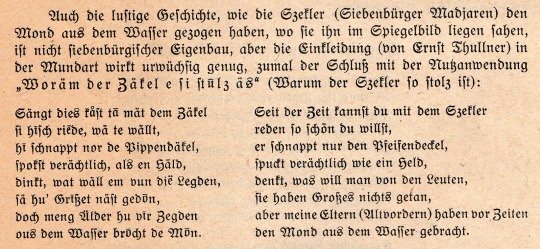
"Woräm der Zäkel e si stūlz äs / Warum der Szekler so stolz ist"
Sängt dies kåst tā mät dem Zäkel
si hīsch riëde, wä te wällt,
hī schappt nor de Pippendäkel,
spokst verächtlich, als en Häld,
dinkt, wat wäll em vun dië Legden,
sä hu' Grīßet näst gedōn,
doch meng Älder hu vīr Zegden
ous dem Wasser brōcht de Mōn.
Seit der Zeit kannst du mit dem Szekler
reden so schön du willst,
er schnappt nur den Pfeifendeckel,
spuckt verächtlich wie ein Held,
denkt, was will man von den Leuten,
sie haben Großes nichts getan,
aber meine Eltern (Altvordern) haben vor Zeiten
den Mond aus dem Wasser gebracht.
Lutz Korodi, "Frohsinn und Lebenswille in siebenbürgisch-sächsischer Dichtung", in Ostland. Vom geistigen Leben der Auslanddeutschen. Zeitschrift. (Hermannstadt/Sibiu), 02/1928
#my scan#ostland#siebenbürgen#siebenbürger sachsen#transylvanian saxons#transylvania#erdély#ardeal#transilvania#romania#poetry#deutsch#1928#székelys#szeklers
9 notes
·
View notes
Text
Büszkén neonáculnak
Facebook
>A Fidesz ötös számú párttagkönyvének büszke tulajdonosával, a 2016-ban lovagkereszttel kitüntetett Bayer Zsolttal kávézott múlt szombaton Alsóörsön Németh Szilárd – derül ki a Fidesz alelnökének nemrég közzétett Facebook-posztjából. Németh Szilárd az alkalomból egy Szekler Army feliratú pólót viselt, de a bejegyzést kísérő fénykép leginkább figyelemre méltó eleme a Bayer Zsolt pólóján…

View On WordPress
0 notes
Text
Okay, so, uh, this is an unusual post. If you were here since the beginning of my blog, you probably know that I am doing this for about 2 years, posting stuff about Romania and its culture.
However, over these past two years, I have kept a part of my identity secret, since I was scared that I may be attacked about it, called a liar or people would question what I've blogged on this blog so far. From my tumblr friends, only my closest friends from the Romanian side of tumblr know about it, and I thank them for being descreet about it.
So, you all know I am Romanian. I was born in Romania, I speak Romanian, I live in Romania. But... I am not fully Romanian... Not in an ethnic way.
I am half Székely. I am a person whose mom is ethnically Romanian, and whose dad is ethnically Székely. Half of my family is Romanian, half is Székely. Half speaks Romanian at home, half speaks Hungarian.
This identity of mine is something I have struggled to accept in the past, due to personal reasons, and only in the past couple of years I have come to embrace the fact that I am not fully Romanian, and that I have Magyar heritage. I am proud of my identity, of my cultures, my languages, and I regret not being able to learn from a young age Hungarian.
But that is not why I kept it a secret. As many of you know, relationships between these groups of people are quite... Messy, to say the least. It's as if every couple of months both sides decide to come after the other. This makes me feel unsafe, it makes me feel cornered, it makes me feel as if people want me to explain and take responsibility for what one side does over the other. I have been disrespected in the past based on my identity, and I honestly do not want that to happen on here.
I love Romania. Romania is my home, it is my country, I am proud of being Romanian, my pride about my nation's history and culture made me make this blog in the first place. I don't want people to think I somehow tried to deceive people by not disclosing in bold letters my status as an ethnical minority, or that I am faking my pride. I am not. It's just that, in my opinion, it wasn't relevant to my blog, for that info to be disclosed.
Today i want to make sure to bring home the idea that my blog is a safe space for people that are Romanian, live in Romania, or anything beyond and in between (apart from people that spread hate or are dangerous to other people). This chunk of land, in between mountains, the sea and a river, is open for everyone. We can all coexist. We all coexist. There shouldn't be fear to say that you are a certain ethnicity or nationality. We are all people.
Thank you for listening to my ramblings tonight. Take care. Noapte bună, jó éjszakát.
#romania#romanian#transylvania#românia#székely#székelyföld#székely land#ținutul secuiesc#szeklerland#szekler#transilvania#ardeal
73 notes
·
View notes
Photo

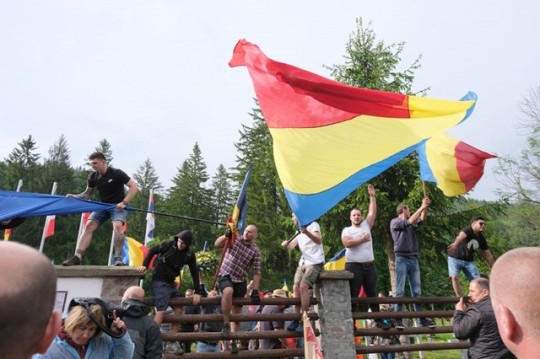
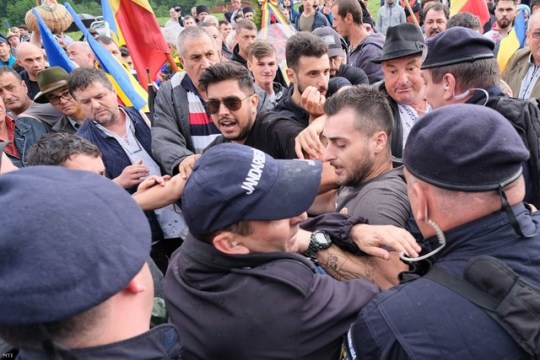
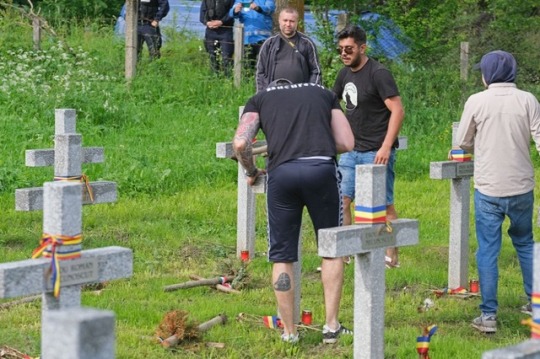
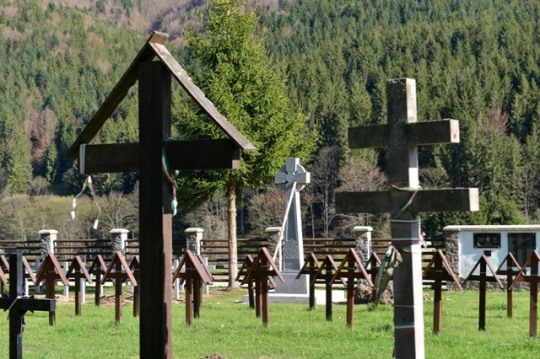
A Mi Hazánk mélységesen elítéli az Úz-völgyi román provokációt
The Mi Hazánk Mozgalom (Our Homeland) condemns the behavior and the provocation of the Romanians, who have destroied the solder's grave in Úzvölgy (Romania).
Mi Hazánk ensures our székely compatriots, that we are expecting the quickest and most powerful reaction from the Hungarian government.
A Mi Hazánk Mozgalom mélységesen elítéli a székelyföldi Úz-völgyében található magyar katonatemetőnél történt román provokációt.
Az egyre gyakoribb magyarellenes akciók sorába illő mostani temetőgyalázás túlmegy minden határon. A románok már nemcsak ártatlan székely fiatalokat vetnek koncepciós per után börtönbe, hanem egykor a hazájukat védő magyar hősök sírhelyeit is meggyalázzák. Az Európai Unió egyszer sem lépett fel és nem is fog a románok újabb és újabb magyarellenes akciói ellen.
A Mi Hazánk szolidaritásáról biztosítja székely honfitársainkat, egyúttal a magyar kormánytól a lehető leggyorsabb és leghatározottabb fellépést várjuk el.
Mi Hazánk Mozgalom
1 note
·
View note
